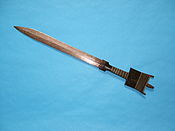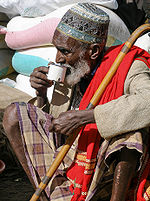- Culture of Somalia
-
Culture of Somalia 
Art Architecture Pottery · Textile Music · Wood carving Language Literature · Mythology Writing systems · Poetry Other Dance · Dress Games · Cuisine Society · History Islam · Festivals · Institutions Science and Technology Maritime · Medicine · Astronomy · Media Cinema · Coinage See also Education · Politics Symbols · Military The culture of Somalia is an amalgamation of traditions indigenously developed or accumulated over a timeline spanning several millennia of Somali civilization's interaction with neighbouring and far away civilizations such as Ethiopia, Yemen, India and Persia.
Contents
Overview
 The billao, a horn-hilted traditional Somali shortsword.
The billao, a horn-hilted traditional Somali shortsword.
The cultural diffusion of Somali commercial enterprise can be detected in its exotic cuisine, which contains Southeast Asian influences. Due to the Somali people's passionate love for and facility with poetry, Somalia has often been referred to by scholars as a "Nation of Poets" and a "Nation of Bards" including, among others, the Canadian novelist Margaret Laurence.[1] Somalis have a story telling tradition. One of the most common daily activities of Somalis is the chewing of khat, a narcotic plant.
Somalis have a rich musical heritage centered on traditional Somali folklore. Most Somali songs are pentatonic; that is, they only use five pitches per octave in contrast to a heptatonic (seven note) scale such as the major scale.
Somali art is the artistic culture of the Somali people, both historic and contemporary. These include artistic traditions in pottery, music, architecture, wood carving and other genres. Somali art is characterized by its aniconism, partly as a result of the vestigial influence of the pre-Islamic mythology of the Somalis coupled with their ubiquitous Muslim beliefs.
Languages
Main articles: Somali language and Languages of SomaliaThe Somali language is the official language of Somalia. It is a member of the Cushitic branch of the Afro-Asiatic language family, and its nearest relatives are the Afar and Oromo languages. Somali is the best documented of the Cushitic languages,[2] with academic studies of it dating from before 1900.
 The Osmanya writing script.
The Osmanya writing script.
Somali dialects are divided into three main groups: Northern, Benaadir and Maay. Northern Somali (or Northern-Central Somali) forms the basis for Standard Somali. Benaadir (also known as Coastal Somali) is spoken on the Benadir coast from Cadale to south of Merca, including Mogadishu, as well as in the immediate hinterland. The coastal dialects have additional phonemes which do not exist in Standard Somali. Maay is principally spoken by the Digil and Mirifle (Rahanweyn) clans in the southern areas of Somalia.
Since Somali had long lost its ancient script,[3] a number of writing systems have been used over the years for transcribing the language. Of these, the Somali alphabet is the most widely used, and has been the official writing script in Somalia since the government of former President of Somalia Siad Barre formally introduced it in October 1972.[4]
The script was developed by the Somali linguist Shire Jama Ahmed specifically for the Somali language, and uses all letters of the English Latin alphabet except p, v and z. Besides Ahmed's Latin script, other orthographies that have been used for centuries for writing Somali include the long-established Arabic script and Wadaad's writing. Indigenous writing systems developed in the twentieth century include the Osmanya, Borama and Kaddare scripts, which were invented by Osman Yusuf Kenadid, Sheikh Abdurahman Sheikh Nuur and Hussein Sheikh Ahmed Kaddare, respectively.[5]
In addition to Somali, Arabic is an official national language in Somalia.[6] Many Somalis speak it due to centuries-old ties with the Arab World, the far-reaching influence of the Arabic media, and religious education.
English is also widely used and taught. Italian used to be a major language, but its influence significantly diminished following independence. It is now most frequently heard among older generations. Other minority languages include Bravanese, a variant of the Bantu Swahili language that is spoken along the coast by the Bravanese people.
Religion
Main article: Islam in Somalia Mosque in Borama, Somalia.
Mosque in Borama, Somalia.
With few exceptions, Somalis are entirely Muslims,[7] the majority belonging to the Sunni branch of Islam and the Shafi`i school of Islamic jurisprudence, although some are also adherents of the Shia Muslim denomination.[8] Sufism, the mystical dimension of Islam, is also well-established, with many local jama'a (zawiya) or congregations of the various tariiqa or Sufi orders.[9] The constitution of Somalia likewise defines Islam as the religion of the Somali Republic, and Islamic sharia as the basic source for national legislation.[10]
Islam entered the region very early on, as a group of persecuted Muslims had, at Prophet Muhummad's urging, sought refuge across the Red Sea in the Horn of Africa. Islam may thus have been introduced into Somalia well before the faith even took root in its place of origin.[11]
In addition, the Somali community has produced numerous important Islamic figures over the centuries, many of whom have significantly shaped the course of Muslim learning and practice in the Horn of Africa, the Arabian Peninsula, and well beyond. Among these Islamic scholars is the 14th century Somali theologian and jurist Uthman bin Ali Zayla'i of Zeila, who wrote the single most authoritative text on the Hanafi school of Islam, consisting of four volumes known as the Tabayin al-Haqa’iq li Sharh Kanz al-Daqa’iq.
Clan and family structure
Main article: Demographics of Somalia This 2002 CIA map shows the distribution of the various Somali clans.
This 2002 CIA map shows the distribution of the various Somali clans.
The clan groupings of the Somali people are important social units, and clan membership plays a central part in Somali culture and politics. Clans are patrilineal and are divided into sub-clans and sub-sub-clans, resulting in extended families.[12]
Somali society is traditionally ethnically endogamous. So to extend ties of alliance, marriage is often to another ethnic Somali from a different clan. Thus, for example, a recent study observed that in 89 marriages contracted by men of the Dhulbahante clan, 55 (62%) were with women of Dhulbahante sub-clans other than those of their husbands; 30 (33.7%) were with women of surrounding clans of other clan families (Isaaq, 28; Hawiye, 3); and 3 (4.3%) were with women of other clans of the Darod clan family (Majerteen 2, Ogaden 1).[13]
Major Somali clans include:
Attire
Men
 Somali man wearing a macawis sarong.
Somali man wearing a macawis sarong.
When not dressed in Westernized clothing such as jeans and t-shirts, Somali men typically wear the macawis (ma'awiis), which is a sarong-like garment worn around the waist. On their heads, they often wrap a colorful turban or wear the koofiyad, an embroidered taqiyah.
Due to Somalia's proximity to and close ties with the Arabian Peninsula, many Somali men also wear the jellabiya (jellabiyad in Somali), a long white garment common in the Arab world.[14]
Women
During regular, day-to-day activities, women usually wear the guntiino, a long stretch of cloth tied over the shoulder and draped around the waist. In more formal settings such as weddings or religious celebrations like Eid, women wear the dirac, which is a long, light, diaphanous voile dress made of cotton or polyester that is worn over a full-length half-slip and a brassiere.
Married women tend to sport head-scarves referred to as shash, and also often cover their upper body with a shawl known as garbasaar. Unmarried or young women, however, do not always cover their heads. Traditional Arabian garb such as the jilbab is also commonly worn.
See also
References
 This article incorporates public domain material from websites or documents of the Library of Congress Country Studies.
This article incorporates public domain material from websites or documents of the Library of Congress Country Studies.
- ^ Diriye, p.75
- ^ A software tool for research in linguistics and lexicography: Application to Somali
- ^ Ministry of Information and National Guidance, Somalia, The writing of the Somali language, (Ministry of Information and National Guidance: 1974), p.5
- ^ Economist Intelligence Unit (Great Britain), Middle East annual review, (1975), p.229
- ^ David D. Laitin, Politics, Language, and Thought: The Somali Experience, (University Of Chicago Press: 1977), pp.86-87
- ^ According to article 7 of The Transitional Federal Charter of the Somali Republic: The official languages of the Somali Republic shall be Somali (Maay and Maxaatiri) and Arabic. The second languages of the Transitional Federal Government shall be English and Italian.
- ^ Middle East Policy Council - Muslim Populations Worldwide
- ^ Mohamed Diriye Abdullahi, Culture and Customs of Somalia, (Greenwood Press: 2001), p.1
- ^ I. M. Lewis, Saints and Somalis: popular Islam in a clan-based society, (The Red Sea Press: 1998), p.8-9.
- ^ The Transitional Federal Charter of the Somali Republic, Article 8, p.6.
- ^ A Country Study: Somalia from The Library of Congress
- ^ Nagendra Kr Singh, International encyclopaedia of Islamic dynasties, (Anmol Publications PVT. LTD.: 2002), p.50.
- ^ Ioan M. Lewis, Blood and Bone: The Call of Kinship in Somali Society, (Red Sea Press: 1994), p.51
- ^ Michigan State University. Northeast African Studies Committee, Northeast African Studies, Volume 8, (African Studies Center, Michigan State University: 2001), p.66.
External links
 SomaliaCapital: Mogadishu
SomaliaCapital: MogadishuTopics Maritime history · Laas Gaal · Land of Punt · Walashma dynasty · Warsangali Sultanate · Adal Sultanate · Ajuuraan State · Dervish State · Gobroon Dynasty · Majeerteen Sultanate · Sultanate of Hobyo · Italian Somaliland · British Somaliland · Ogaden War · Somalian Revolution (1986–1992) · History of Somalia (1991–2006) · Somali Civil War · Unified Task Force · Piracy in Somalia · War in Somalia (2006–2009) · War in Somalia (2009–)CultureArchitecture · Art · Cinema · Cuisine · Languages · Literature · Music · Christianity · Islam · Sports · Coat of arms · Flag · National anthemPost-war divisions Declared statesIslamist administrationsFormer administrationsProposed statesPre-war divisions Awdal · Bakool · Banaadir · Bari · Bay · Galguduud · Gedo · Hiiraan · Jubbada Dhexe · Jubbada Hoose · Mudug · Nugaal · Sanaag · Shabeellaha Dhexe · Shabeellaha Hoose · Sool · Togdheer · Woqooyi GalbeedCulture of Africa Sovereign
states- Algeria
- Angola
- Benin
- Botswana
- Burkina Faso
- Burundi
- Cameroon
- Cape Verde
- Central African Republic
- Chad
- Comoros
- Democratic Republic of the Congo
- Republic of the Congo
- Côte d'Ivoire (Ivory Coast)
- Djibouti
- Egypt
- Equatorial Guinea
- Eritrea
- Ethiopia
- Gabon
- The Gambia
- Ghana
- Guinea
- Guinea-Bissau
- Kenya
- Lesotho
- Liberia
- Libya
- Madagascar
- Malawi
- Mali
- Mauritania
- Mauritius
- Morocco
- Mozambique
- Namibia
- Niger
- Nigeria
- Rwanda
- São Tomé and Príncipe
- Senegal
- Seychelles
- Sierra Leone
- Somalia
- South Africa
- South Sudan
- Sudan
- Swaziland
- Tanzania
- Togo
- Tunisia
- Uganda
- Zambia
- Zimbabwe
States with limited
recognition- Sahrawi Arab Democratic Republic
- Somaliland
Dependencies and
other territories- Canary Islands / Ceuta / Melilla / Plazas de soberanía (Spain)
- Madeira (Portugal)
- Mayotte / Réunion (France)
- Saint Helena / Ascension Island / Tristan da Cunha (United Kingdom)
- Western Sahara
Categories:- Somalian culture
Wikimedia Foundation. 2010.
